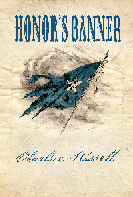

 |
 Click on cover to read inside the book |
The Northern Methodist Church in the South During Occupation and Reconstruction
There are two scenes in Honor’s Banner in which I depict Northern Methodists who came South during Reconstruction. Mine is not a favorable opinion of these people and my depiction of the fictional characters I have drawn readily reflects this. I base my opinion on the following synopsis of the group as a whole: The Methodist Episcopal Church, South, separated from the northern branch of the Methodist Episcopal Church in 1844, in a schism over slavery. At the time of the split, assets were divvied up amicably. It was not until the next general conference of the Methodist Episcopal Church that animosity appeared, and that animosity manifested itself in the leadership of the Northern church (oh, duh, theirs was the only leadership present, the Southern church now being out). In time, the Northern church’s hate grew to envelop not only the Southern church, but the entire South. The beliefs expressed by these people in their own journals—The Central Christian Advocate, Ladies Repository, Methodist, Methodist Advocate, Methodist Review, Missionary Advocate, Western Christian Advocate, and Zion’s Herald—to cite only a few; minutes of their annual conferences; and the official publications of the Methodist Episcopal Church bring to light a self-righteous, hate-filled, insufferable people incestuously tied to the central government, which supported their ultimately failed effort to scour the South of the Southerner. I am not speaking of the imposition of their brand of religion on the South, Methodism is Methodism. I am talking about social and political mores they incorporated as part of their religion. These people believed that the Republicans (especially the Radicals) were intimately tied to God’s will for the nation, that Methodism was “loyalty,” and that the North’s victory over the South was the signal for the initiation of a great moral regeneration of the nation. In November 1863, the War Department issued an order applicable to the Southwestern states of the Confederacy authorizing Northern Methodists to occupy “all houses of worship belonging to the Methodist Episcopal Church, South in which a ‘loyal’ minister, appointed by a ‘loyal’ bishop of said church, does not officiate.” Read that again—The War Department. This refers to territory that by the summer of 1863 had fallen under Union control and included a significant part of Mississippi. Aided by the United States Army, these people occupied the property of the Southern Methodists. By the time depicted in Honor’s Banner, physical subjugation of the South was complete, and the Methodist church was sending “missionaries” south to remove the institutional debris and reorganize Southern society, restore civil order, and ensure dependence on moral and religious influences. The central government was heavily sprinkled with fanatics in powerful positions. The Methodist Episcopal Church was painfully political. It was the religious wing of the Republican Administrations of that day and was, I quote, “the God-appointed church to redeem and possess the South.” In the eyes of these people, the South was a malignancy affecting the nation, and the only hope was that the Methodist Episcopal Church would impregnate the South with Northern ideas and civilization. I could go on and on in this vein, but suffice it to say the endless stream of words from these peoples’ mouths, which they proudly put in print, were so belittling and hateful it is hard not to think of those who spoke them as caricatures. Indeed, to portray these people in fiction makes them look like cardboard villains. Sadly, they were real, and they truly believed they were God’s gift to the nation and the South’s only salvation. At the time of his death, Lincoln had begun returning these properties to the Methodist Episcopal Church, South. This reversal of policy continued under Andrew Johnson. The Methodist Episcopal Church was not in bed with Johnson, though it had been with Lincoln to some extent. Rather, the Methodist Episcopal Church was in bed with Congress. This change in policy proved a problem for the Church in that there was a dearth of locations where their adherents could worship. Northern Methodists worked intimately with the Freedmen’s Bureau in support of freed slaves and later had roles in the puppet Reconstruction civil governments established in the occupied states. Their primary adherents, ultimately, proved to be freed black folk, and to their rare credit, the Northern Methodists did play an important role in establishing early educational facilities for the illiterate black man. For a good overview on the Northern Methodists during this period, I refer the reader to Ralph E. Morrow’s Northern Methodism and Reconstruction (1950). As an adjunct to this subject, I refer the reader to this very enjoyable article dealing with the self-righteousness of the (New England) Yankee.
Copyright Notice "Loblolly Writer's House Site" Copyright © 2006 by Charlsie Russell All rights reserved on all material on all pages in this site, plus the copyright on compilations and design, graphics, and logos except as noted. For information on reprinting material from this site, please contact |
| Home Page | About Loblolly Writer House's Books | Mississippi History Page | Go here to buy books | Go here to learn about forming your own small press | Contact us |